|
Biographical Log of Michael Furstner - Page 50
2008 : Jan |
Feb |
Mar |
Apr |
May |
Jun |
Jul |
Aug |
Sep |
Oct |
Nov |
Dec | Page :
Previous |
Next |
Most Recent -
Next -
Previous -
Page 1 -
Photos -
Index -
Topics -
Jazclass Links
Sunday October 26, 2008
(diary, book)
Last night I recorded Por qué, a Jazz waltz I wrote in
2002. That brings the total number of my online recordings to 10. I
will probably do more of them once I am settled in at the Sunshine
Coast next month.
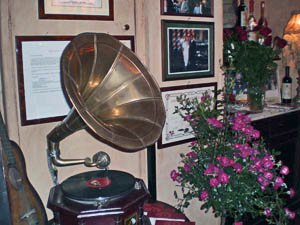 I watched some TV, went to bed but could not get to sleep, so I kept
reading F. Scott Fitzgerald's book 'Tender is the Night'. I
really find it a fascinating read. His style of expression is so
totally different and unique, it sets (in my mind) him and Ernest
Hemingway apart as the two most innovative modern writers of the
20th Century.
I watched some TV, went to bed but could not get to sleep, so I kept
reading F. Scott Fitzgerald's book 'Tender is the Night'. I
really find it a fascinating read. His style of expression is so
totally different and unique, it sets (in my mind) him and Ernest
Hemingway apart as the two most innovative modern writers of the
20th Century.
His way of expressing, describing and associating events, people,
places, situation, etc. fluctuates between impressionistic and
downright surrealistic. You need to read rather slowly and
think through what he writes in order to absorb the true picture.
Let me give you a couple of small cameo descriptions of his so that
you get some idea of his style.
The two main characters of the
book, Dick and Nicole, are listening to some old records (Nicole's
sister has sent from America) on a portable phonograph one evening in
a garden in Switzerland :
The thin tunes, holding lost times and future hopes in
liaison, twisted upon the Swiss night. In the lulls of the phonograph
a cricket held the scene together with a single note
......... |
Here is how Dick feels about Nicole :
He (Dick) was enough older than Nicole to take
pleasure in her youthful vanities and delights, the way she paused
fractionally in front of the hall mirror on leaving the restaurant, so
that the incorruptible quicksilver could give her back to herself.
He delighted in her stretching out her hands to new octaves now
that she found herself beautiful and rich.
|
Fitzgerald (reputedly) gave a name to the age he
lived in : the Jazz Age. How appropriate, because one could
describe his writing too as creative, unique improvisations over known
and existing chord progressions (the world we know and live in).
This morning after watching part of the ABC Sunday morning program
Andrew invites me for breakfast at the farm. Everybody else is there
too and I enjoy a great feed of poached eggs, hash brown, bacon and
baked beans.
And talking about food : I have a craving for
bitterballen. We used to get them from a Dutch shop in Brisbane
over Christmas. This year I plan to do better. We are going to make
them ourselves !! I just download the recipe from the internet. Look
forward to trying this out.
Most Recent -
Next -
Previous -
Top -
Page 1 -
Photos -
Index -
Topics -
Jazclass Links
Monday October 27, 2008
(diary, improvisation)
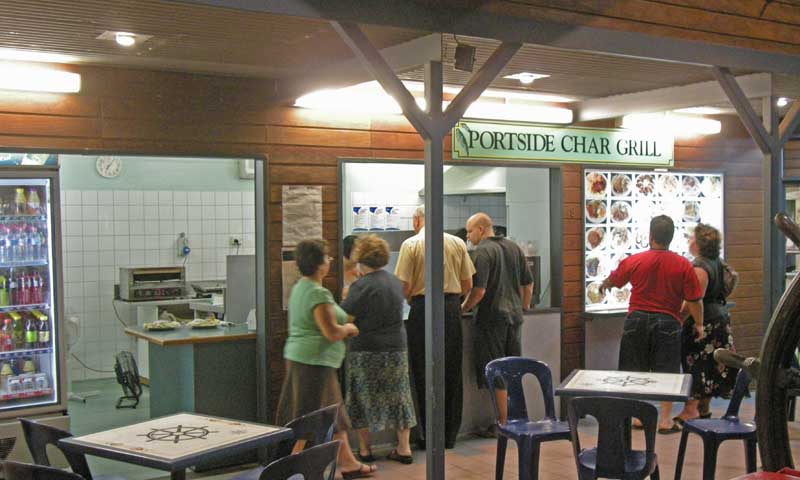 After the big breakfast yesterday morning I had no taste to go for
lunch somewhere but in the evening I decided to drive to Stokes Hill
Wharf. To my surprise there were quite a lot of people there, even
some tourists although the main season is well and truly over. At the
table next to me sat four tourists speaking with a clear Southern
German accent. They were in fact Austrians from Vienna, as I found
out after having taken a photo for them.
After the big breakfast yesterday morning I had no taste to go for
lunch somewhere but in the evening I decided to drive to Stokes Hill
Wharf. To my surprise there were quite a lot of people there, even
some tourists although the main season is well and truly over. At the
table next to me sat four tourists speaking with a clear Southern
German accent. They were in fact Austrians from Vienna, as I found
out after having taken a photo for them.
It was a lovely evening,
not hot at all, just nice. My seafood grill from the Portside Char
Grill (not 'Northside Char Grill' as I have mistakenly been
calling them previously) was once again excellent. The humble
appearance of their shop belies the quality of the food they serve. I
consider them by far the best on the Wharf.
My period of MP3
recording has once again brought to my mind the various approaches
one can have to improvisation, especially of course Jazz
improvisation. There are in fact four of them.
1. Use your own composition
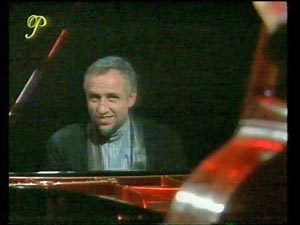 This is what for example the French pianist Jacques Lousier has done.
He has worked out one improvisation for each piece he plays, then
plays it again and again, note for note, at every performance (either
from a written transcription or from memory).
This is what for example the French pianist Jacques Lousier has done.
He has worked out one improvisation for each piece he plays, then
plays it again and again, note for note, at every performance (either
from a written transcription or from memory).
There is something to
say for this approach when you are a star performer and you
have to deliver the goods each and every time, but I personally find
it most disappointing. It goes against the spirit and intention of
what Jazz is all about.
I had been listening to Lousier's records
for years, then 10 or 15 years later I went to one of his live
performances in Canberra. He still played every solo exactly the same
as on the records we had from him.
2. Improvise following a set series of
ideas
This is an interesting idea promoted by the American saxophonist and
educator David Liebman.
I became familiar with this
approach at a private lesson from one of Liebman's students. You take
a blank piece of manuscript paper and write down a series of cameo
ideas at appropriate points of the song's chorus.
The idea maybe
only one bar in length and can be the start of a phrase, an arpeggio,
the beginning of a digital pattern, etc. You may have just one idea
for an entire chorus, then another one if you are soloing over a
second chorus. Or you may have different ideas at shorter
intervals, say every 8 or 16 bars.
The ideas may not even be all your
own either. You may listen to a record or performance by someone else
and think "Hey, that is a great idea. I am going
to try that too." This happens a lot in Jazz, and is an
important mechanism through which it develops an ever expanding
vocabulary.
This approach is clearly a good one for quality professional
performers. They have their set combination of ideas for a song,
ensuring a good standard of performance, while at the same time they
can discard it at any instant during their solo if they find they are suddenly on a roll with
something new.
3. Have the first phrase in your mind before
you start
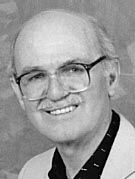 This is what the well known Australian former ABC arranger, composer
and pianist Eric Bryce told me he always does. He mainly does
it for the very first song of his performance, just to get off on a
good start. Once that is accomplished he is right for the
session.
This is what the well known Australian former ABC arranger, composer
and pianist Eric Bryce told me he always does. He mainly does
it for the very first song of his performance, just to get off on a
good start. Once that is accomplished he is right for the
session.
This is more a psychology thing than anything else.
Curiously, exactly the same happens when playing contract bridge (or any other sport I imagine). If
the first game you play goes well you are right for the evening. But
if you make a big mistake, it takes a hell of a long time before you
get
back on track.
4. Let the mood of the moment inspire
you
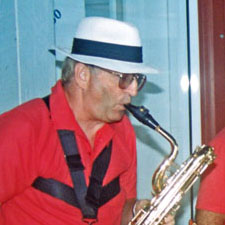 This is total freedom and of course a lot of fun. The band or backing
track, the song itself and the audience (if there is one) set you in a certain mind
frame which propels you into your solo. If you play different
instruments then the one you play and the technical skill you have
over it are also most important.
This is total freedom and of course a lot of fun. The band or backing
track, the song itself and the audience (if there is one) set you in a certain mind
frame which propels you into your solo. If you play different
instruments then the one you play and the technical skill you have
over it are also most important.
But be aware, starting an
improvised solo is like standing at a road intersection. Which
way are you going, North, East, South or West ? The first couple of
steps will determine your direction. Likewise the first two or
three notes will set the direction and course of your
solo.
|
Playing on my Korg PA1X electronic keyboard I have of course the same technical skill levels regardless the instrument sound I select. But it does bring me very much in the mood of the selected instrument and my improvisation is strongly influenced by that.
As I play 2 or 3 choruses on each recording, and in order not to play a similar improvisation each time I do have either a couple of starting notes in mind for a chorus or I deliberatly go into a different direction (up, down, sideways note sustained or repeated). Well, that is if I don't forget of course.
Most Recent -
Next -
Previous -
Top -
Page 1 -
Photos -
Index -
Topics -
Jazclass Links
Tuesday - Thursday October 28-30, 2008
(diary)
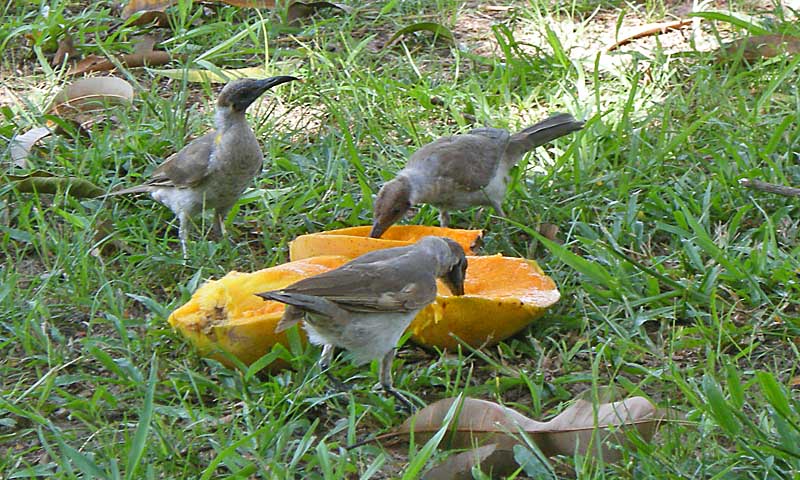 The week before I leave on a trip I always feel restless and
somewhat unsettled. I want to get on with it, but it is not yet time
to go. Much of the time I sit on my veranda watching the birds. I have
cut some of the mangos which have fallen from the tree in half so that
the small birds don't have to pick their way through the tough
outer skin. They hugely enjoy this and keep eating all day. I am trying to get a good closeup shot of one of the mango geese, but it is impossible with my Coolpix camera. They are so shy you just can't come close enough to them.
The week before I leave on a trip I always feel restless and
somewhat unsettled. I want to get on with it, but it is not yet time
to go. Much of the time I sit on my veranda watching the birds. I have
cut some of the mangos which have fallen from the tree in half so that
the small birds don't have to pick their way through the tough
outer skin. They hugely enjoy this and keep eating all day. I am trying to get a good closeup shot of one of the mango geese, but it is impossible with my Coolpix camera. They are so shy you just can't come close enough to them.
I had my last bridge evening with Mairead at the
Arafura Bridge Club on Monday and with Freda in Palmerston tonight
(Thursday). We always enjoy our evenings together and I will mis them both. I don't play bridge during my stay at the Sunshine Coast
but probably will make a short trip to Adelaide (around February) to
see Shirley's mother Irene and have a game with my old bridge
club there then too.
Today I start packing, and have my last
lunch at Bar Zushi for a while.
Most Recent -
Next -
Previous -
Top -
Page 1 -
Photos -
Index -
Topics -
Jazclass Links
Friday October 31, 2008
(diary)
 I am always intraegued by the world, especially nature on a small scale. This last week or so tiny purple flowers are appearing everywhere along the track to the pump house on the farm. These flowers at just 1 cm in diameter. The setting with dead leaves, twigs, etc. form a true abstract picture, but based as I prefer it on reality.
I am always intraegued by the world, especially nature on a small scale. This last week or so tiny purple flowers are appearing everywhere along the track to the pump house on the farm. These flowers at just 1 cm in diameter. The setting with dead leaves, twigs, etc. form a true abstract picture, but based as I prefer it on reality.
The painter Kandinsky started his journey into abstract art when looking through a microscope. I can very much identify with that. During my geology training I studied numnerous thin sections of igneous rocks in polarised light under the microscope. It opened up a wonderful, enormously colourful world to me.
In the morning I pick a load of mangos, some for Jeroen and Lisa, some to take with me for Babette, Doug and myself. Then some packing which takes about 2 hours. Lunch with Jeroen at Stokes Hill Wharf, where I say goodbye to the Phi, the owner of the Portside Char Grill. Some shopping on my way back home. I buy lots of soft drinks, fruit juice, bananas for my trip the next few days. So I am well organised.
I have a Sax student at 5pm and a quiet evening, resting before my departure early tomorrow morning.
Comments -
Most Recent -
Next Page -
Previous -
Top -
Page 1 -
Photos -
Index -
Topics -
Jazclass Links
Copyright © 2008 Michael Furstner
|
 I watched some TV, went to bed but could not get to sleep, so I kept
reading F. Scott Fitzgerald's book 'Tender is the Night'. I
really find it a fascinating read. His style of expression is so
totally different and unique, it sets (in my mind) him and Ernest
Hemingway apart as the two most innovative modern writers of the
20th Century.
I watched some TV, went to bed but could not get to sleep, so I kept
reading F. Scott Fitzgerald's book 'Tender is the Night'. I
really find it a fascinating read. His style of expression is so
totally different and unique, it sets (in my mind) him and Ernest
Hemingway apart as the two most innovative modern writers of the
20th Century.





